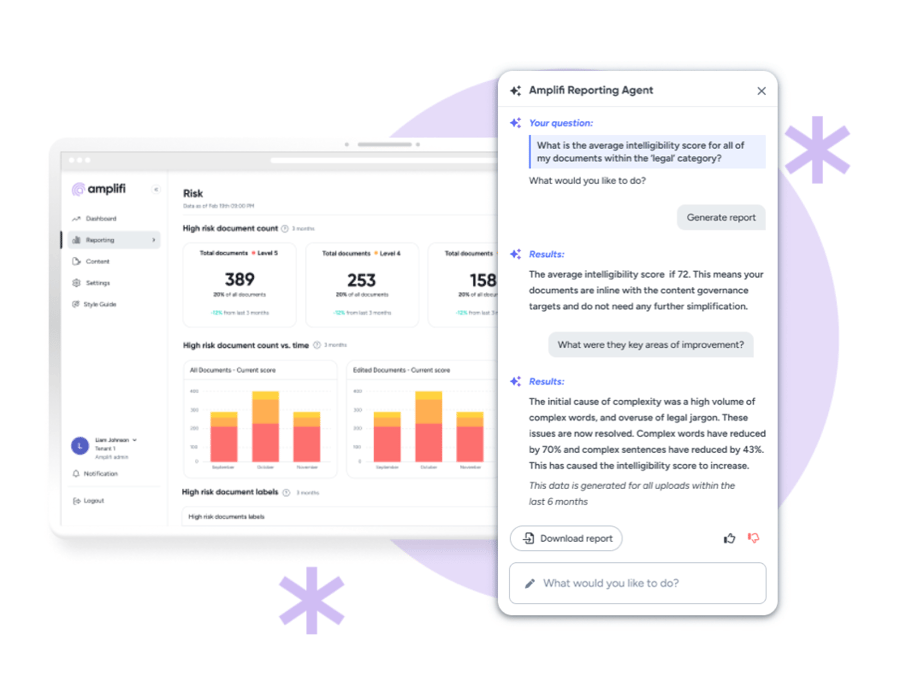Built For You. All In One.
Everything you need to measure, manage, and improve the intelligibility of your communications.
It all start with the score
Powered by our Cognitive Risk Engine™
Our AI-powered engine analyses language complexity to assess how understandable human and AI-generated content is.
This delivers a true measure of understanding. Not just how content reads but how it’s likely to be understood.
Paired with guided suggestions and intelligible GenAI rephrasing, Amplifi enables organisations to proactively identify and address confusing or high-risk content before it reaches consumers.
Aligned to how your teams already work
How Amplifi Fits Into Your Workflow
Amplifi supports the full document lifecycle from testing and editing to reporting. Our AI platform creates intelligibility benchmarks to, streamline content creation, and sign-off processes, showing compliance outcomes at every stage.
Identify the high risk comms
Assess
Gain clear starting points for improving content quality and reducing regulatory exposure
- Quickly identify high-risk communications with Amplifi’s proprietary Intelligibility Risk Score
- Instantly assess content at scale to uncover areas needing attention
- Prioritise documents that pose compliance or clarity risks
- Benchmark performance by team, product, channel, or document type
Guided and efficient
Simplify
Focus on improving the content that matters most to consumers and regulators
- Visualise risk instantly with colour-coded highlights for complex or unclear text
- Get guided suggestions and AI-powered intelligible rephrasing to improve clarity and tone
- Automatically flag issues with intelligibility, readability, sentence structure, and conceptual load
- Streamline content refinement with intelligent, user-friendly editing support
Meet your compliance goals
Review & Sign off
Ensure every piece of content meets compliance and quality standards before release
- Collaborate seamlessly across teams with real-time commenting and feedback
- Track intelligibility improvements over time with version-by-version comparisons
- Embed review and approval steps directly into your content governance workflow
- Speed up sign-off while maintaining accountability across stakeholders
Get your content live
Publish
Push confident, compliant content into production with built-in quality checks
- Mark content as “ready” once it meets intelligibility and clarity thresholds
- Ensure regulatory deliverables are timely, targeted, and thoroughly tested
- Link content directly to product journeys or compliance checkpoints for full traceability
- Streamline content approval and launch processes with clear governance built-in
Get your content live
Internal Reporting & QA
Track and measure content clarity as a key performance indicator
- Monitor team productivity and progress across projects and workflows
- Segment results by business unit, product type, campaign, or document group for targeted insights
- Identify and address content risks early before they impact compliance or customer trust
- Support continuous improvement with data-driven quality assurance
High level MI reports
External Reporting
Build trust with regulators, boards, and stakeholders through evidence-based reporting
- Generate FCA Consumer Duty – ready reports to support compliance and transparency
- Demonstrate your testing, improvements, and decision-making journey with clear data at scale
- Export reports by timeline, product, or document type for tailored insights (e.g. weekly, monthly, annually)
- Map your data directly to FCA Handbook requirements and guidance for streamlined regulatory alignment

Integrate with your existing BAU tools
Third party integrations
Seamless integration with Figma and MS Word, PowerPoint, OutLook via the Amplifi plugin
- Generate real-time intelligibility scores directly within your design and document tools
- Access AI-powered intelligible suggestions without leaving third-party apps
- Export PDF reports straight from Figma or Word for easy sharing and compliance tracking
- Sync content to the Amplifi platform for centralised analysis and aggregated reporting
-
Content management system (API) integration for Intelligibility scoring within your own content system - MS Sharepoint, Adobe CM, G-Suite**
*MS integration coming Q4 2025. API integration coming Q1 2026
.png?width=655&height=572&name=Group%201171278114%20(2).png)
Control how content is created by teams
Content governance & standards tools
Create your own standards and automate content control with rule-based systems that flag risks and guide editors during drafting.
- Terms & Phrases Library – Define approved and banned terms to maintain consistency and reduce risk across all communications
- Enforce writing standards – Apply consistent tone of voice, inclusive and accessible language, grammar, and punctuation
- Support compliance and brand alignment by embedding governance directly into the content creation workflow
- Definitions Library – Standardise key terms with clear, pre approved definitions and explainers
.png?width=728&height=533&name=ai%20(1).png)
Control access and permissions
Teams & permissions
Build and manage teams and ensure only the right people have access to the right documents.
- Create and manage cross-functional teams (Legal, Content, Design, Comms, etc.) for streamlined collaboration
- Build teams across different departments or content creators to support complex workflows
- Easily share documents with individuals, specific teams, or your entire organisation
- Assign tailored access levels — view-only, edit, or full ownership — based on roles and responsibilities*
*Coming Q1 2026

Automate and streamline your workflows
Amplifi AI agents
Amplifi agents will be used across the platform to automate key tasks, provide insights and create efficiency for users.*
*Coming in Q4 2025

Best in class training for all users
The Amplifi Intelligibility Academy
Amplifi provides best in class training for all users. Training modules can be accessed online within the platform, ensuring all users get the most value from the tool.
- Intelligibility training – Be a champion for clear communication: know what intelligibility means, what affects it, and what the law requires
- Workflow training – Learn to integrate Amplify into your compliance workflows, use its reports, and share insights with your team.
- Using Amplifi – An online resource with workshops and training videos on using the Amplifi tool.
- Design and layout - Learn to design legal and regulated documents for clarity, engagement, and compliance.